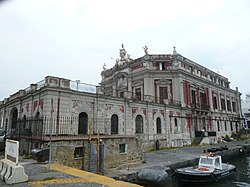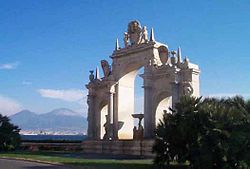| This article does not cite any sources. Please help improve this article by adding citations to reliable sources. Unsourced material may be challenged and removed. Find sources: "Palace of the Immacolatella, Naples" – news · newspapers · books · scholar · JSTOR (December 2009) (Learn how and when to remove this message) |
The Palace of the Immacolatella is a late Baroque style palace at water's edge in Naples, Italy.


The palace design is attributed to the multifaceted painter, sculptor, and architect, Domenico Antonio Vaccaro and it was completed in 1740s to the quarantine station for the port of Naples. At the time, it stood on a peninsula connected to the mainland, connected through the church of Santa Maria del Portosalvo (Holy Mary of the Safe Haven). The area to the north was filled in the 1930s
The palace is so named because of the statue of the Immaculate Conception by Francesco Pagano, which stands on the roof line over the entrance. The famous Immacolatella fountain, now called Fountain of the Giant, was initially associated with the building, and designed by Michelangelo Naccherino. It was relocated and now stands on the seaside road, via Nazario Sauro, near the Castel dell'Ovo.
40°50′29″N 14°15′33″E / 40.841426°N 14.259103°E / 40.841426; 14.259103
This article about an Italian building or structure is a stub. You can help Misplaced Pages by expanding it. |